Stimulates Immune Gene Expression and Inhibits Development in
The over-replicating wMelPop strain of the endosymbiont Wolbachia pipientis has recently been shown to be capable of inducing immune upregulation and inhibition of pathogen transmission in Aedes aegypti mosquitoes. In order to examine whether comparable effects would be seen in the malaria vector Anopheles gambiae, transient somatic infections of wMelPop were created by intrathoracic inoculation. Upregulation of six selected immune genes was observed compared to controls, at least two of which (LRIM1 and TEP1) influence the development of malaria parasites. A stably infected An. gambiae cell line also showed increased expression of malaria-related immune genes. Highly significant reductions in Plasmodium infection intensity were observed in the wMelPop-infected cohort, and using gene knockdown, evidence for the role of TEP1 in this phenotype was obtained. Comparing the levels of upregulation in somatic and stably inherited wMelPop infections in Ae. aegypti revealed that levels of upregulation were lower in the somatic infections than in the stably transinfected line; inhibition of development of Brugia filarial nematodes was nevertheless observed in the somatic wMelPop infected females. Thus we consider that the effects observed in An. gambiae are also likely to be more pronounced if stably inherited wMelPop transinfections can be created, and that somatic infections of Wolbachia provide a useful model for examining effects on pathogen development or dissemination. The data are discussed with respect to the comparative effects on malaria vectorial capacity of life shortening and direct inhibition of Plasmodium development that can be produced by Wolbachia.
Published in the journal:
. PLoS Pathog 6(10): e32767. doi:10.1371/journal.ppat.1001143
Category:
Research Article
doi:
https://doi.org/10.1371/journal.ppat.1001143
Summary
The over-replicating wMelPop strain of the endosymbiont Wolbachia pipientis has recently been shown to be capable of inducing immune upregulation and inhibition of pathogen transmission in Aedes aegypti mosquitoes. In order to examine whether comparable effects would be seen in the malaria vector Anopheles gambiae, transient somatic infections of wMelPop were created by intrathoracic inoculation. Upregulation of six selected immune genes was observed compared to controls, at least two of which (LRIM1 and TEP1) influence the development of malaria parasites. A stably infected An. gambiae cell line also showed increased expression of malaria-related immune genes. Highly significant reductions in Plasmodium infection intensity were observed in the wMelPop-infected cohort, and using gene knockdown, evidence for the role of TEP1 in this phenotype was obtained. Comparing the levels of upregulation in somatic and stably inherited wMelPop infections in Ae. aegypti revealed that levels of upregulation were lower in the somatic infections than in the stably transinfected line; inhibition of development of Brugia filarial nematodes was nevertheless observed in the somatic wMelPop infected females. Thus we consider that the effects observed in An. gambiae are also likely to be more pronounced if stably inherited wMelPop transinfections can be created, and that somatic infections of Wolbachia provide a useful model for examining effects on pathogen development or dissemination. The data are discussed with respect to the comparative effects on malaria vectorial capacity of life shortening and direct inhibition of Plasmodium development that can be produced by Wolbachia.
Introduction
Wolbachia pipientis is an intracellular maternally inherited bacterial symbiont of invertebrates that is very common in insects, including a number of mosquito species [1], [2]. It can manipulate host reproduction in several ways, including cytoplasmic incompatibility (CI), whereby certain crosses are rendered effectively sterile. Females that are uninfected produce infertile eggs when they mate with males that carry Wolbachia, while there is a ‘rescue’ effect in Wolbachia-infected embryos such that infected females can reproduce successfully with any males. Therefore uninfected females suffer a frequency-dependent reproductive disadvantage. Wolbachia is able to rapidly invade populations using this powerful mechanism [3]–[5].
A strain of Wolbachia called wMelPop has been identified that over-replicates in somatic tissues and roughly halves the lifespan of laboratory Drosophila melanogaster [6]. A transinfection of wMelPop from Drosophila into the mosquito Aedes aegypti also leads to a similarly shortened lifespan in the lab, as well as inducing strong CI, which has made it a very promising candidate for the development of new strategies for controlling mosquito-borne diseases [7]. All mosquito-borne pathogens require an extrinsic incubation period before they can be transmitted that is relatively long (∼9 days for malaria) compared to mean mosquito lifespan in the field; therefore, a reduction in the number of old individuals in the population will reduce disease transmission [8]–[11].
We recently found that the presence of wMelPop also produces a major upregulation of a large number of immune genes in Ae. aegypti and inhibits the development of filarial nematode worm parasites [12]. We hypothesized that the two effects are functionally related – higher levels of immune effectors in wMelPop-infected mosquitoes render them better able to kill parasites [12]. Homologs of some of the Ae. aegypti genes that are upregulated in the presence of wMelPop have been previously shown to have the ability to regulate development of Plasmodium parasites in Anopheles, for example a transgene encoding cecropin-A/a synthetic cecropin-B of Hyalophora cecropia; the NF-κB-like transcription factor Rel2 controlling the Imd pathway; and TEP (Thioester containing) opsonization proteins [13]–[20]. It has recently been shown that the wMelPop-infected Ae. aegypti line has impaired ability to transmit an avian malaria, Plasmodium gallinaceum [21]. It is possible that these effects of wMelPop could be particular to the Ae. aegypti transinfection; however, if comparable upregulation of orthologous immune genes, and inhibition of Plasmodium development are also seen in the important Anopheles vectors of human malaria, it may provide a stimulus to the development of new Wolbachia-based malaria control strategies.
To address this question we used Anopheles gambiae, the most important vector of malaria in Africa, which like Ae. aegypti is not naturally infected with Wolbachia. The creation of stably inherited lines of An. gambiae is likely to require a long period of microinjection and selection, as had to be performed for Ae. aegypti [7]. However, in advance of the successful creation of an An. gambiae stable transinfection, the effects of the presence of wMelPop on immunity and malaria transmission can be tested using an established wMelPop-infected An. gambiae cell line [22] and the ability to create somatic lifetime infections of Wolbachia in adult female mosquitoes by intrathoracic inoculation [23], [24]. The wMelPop strain forms disseminated somatic infections in its natural Drosophila host [6], in common with some but not all Wolbachia strains [25]. Given that a) Plasmodium parasites will travel solely through somatic tissues on their journey to the salivary glands, and b) that many of the known antimalarial immune effectors are humoral/systemic, we consider that the creation of somatic infections of Wolbachia via adult inoculation represents a useful model for stably inherited germline-associated infections. To examine this hypothesis further, we also created somatic wMelPop infections in Ae. aegypti, in order to compare the magnitude of the effects on mosquito immunity and filarial nematode parasite development with those observed in the stably wMelPop-transinfected line.
Results
Immune gene expression in An. gambiae
Given that a stable wMelPop infection of An. gambiae does not yet exist, it was necessary to create transient somatic infections by intrathoracic innoculation with purified Wolbachia. RNA from these transinfected females was then tested for expression levels of six immune genes, and upregulation of all these genes was observed compared to buffer injected and E. coli - injected controls (Figure 1). Of these genes, LRIM1 and TEP1 (whose products have been shown to interact in the opsonisation response) have previously been shown to have an important inhibitory or antagonistic effect on Plasmodium development [18]–[20]. Importantly, injected mosquitoes were left for eight days before Plasmodium challenge or qRT-PCR, and therefore the pulse of immune gene upregulation caused by the injury itself or by the E. coli challenge would be expected to have already passed [15].
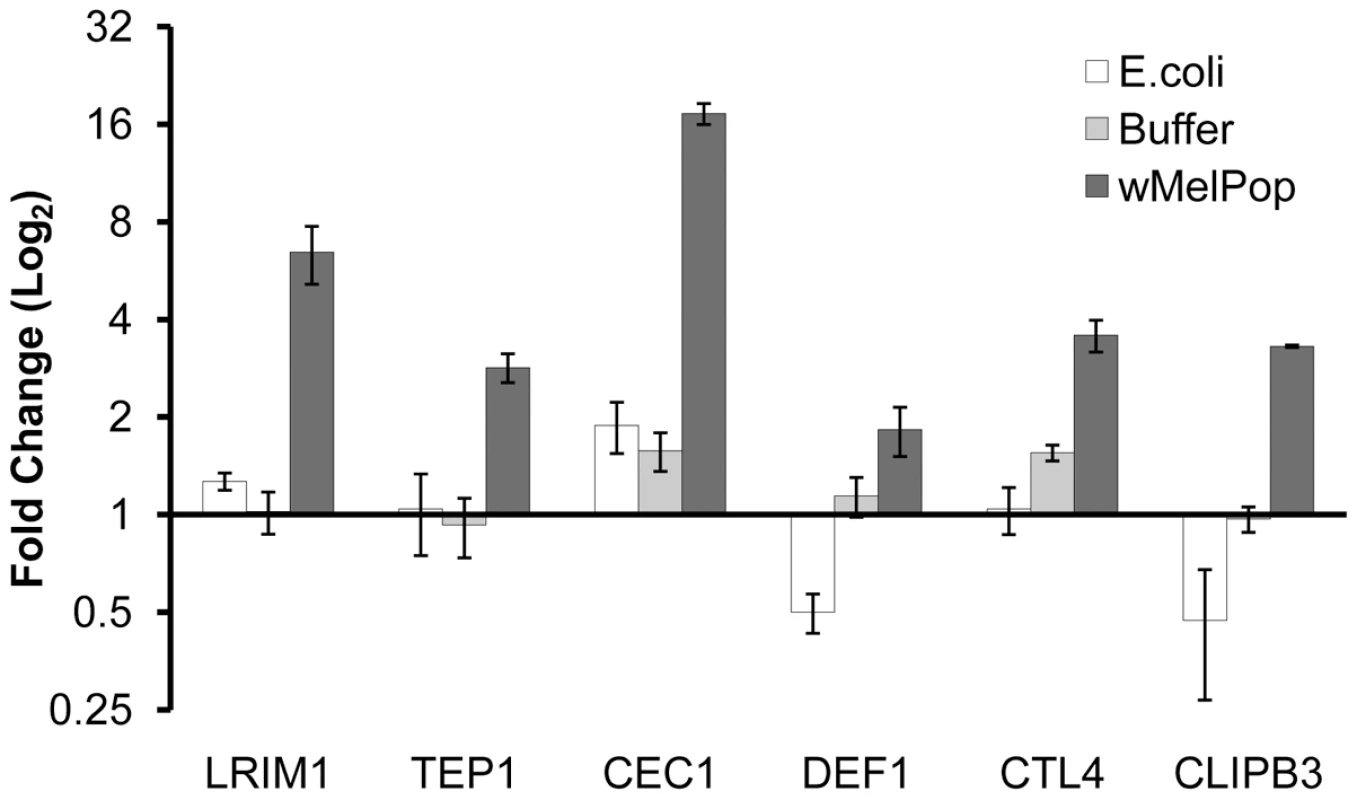
The wMelPop infected cell line MOS55 [22] showed upregulation of all six selected immune genes compared to an uninfected cell line created by tetracycline curing of infected MOS55 (Figure 2). These data add confidence to the hypothesis that it is the presence of wMelPop itself that is inducing immune gene upregulation, and by extension Plasmodium inhibition, and that these effects are not artefacts of the intrathoracic injection process. The degree of upregulation was different for some genes in the cell line than observed for the somatic in vivo transinfection. However these differences would be expected given that many immune genes are primarily expressed in particular cell types/organs in adult mosquitoes, such as the fat body cells or in the case of TEP1, the haemocytes [18], and the cellular composition of this larval-derived cell line is unknown.
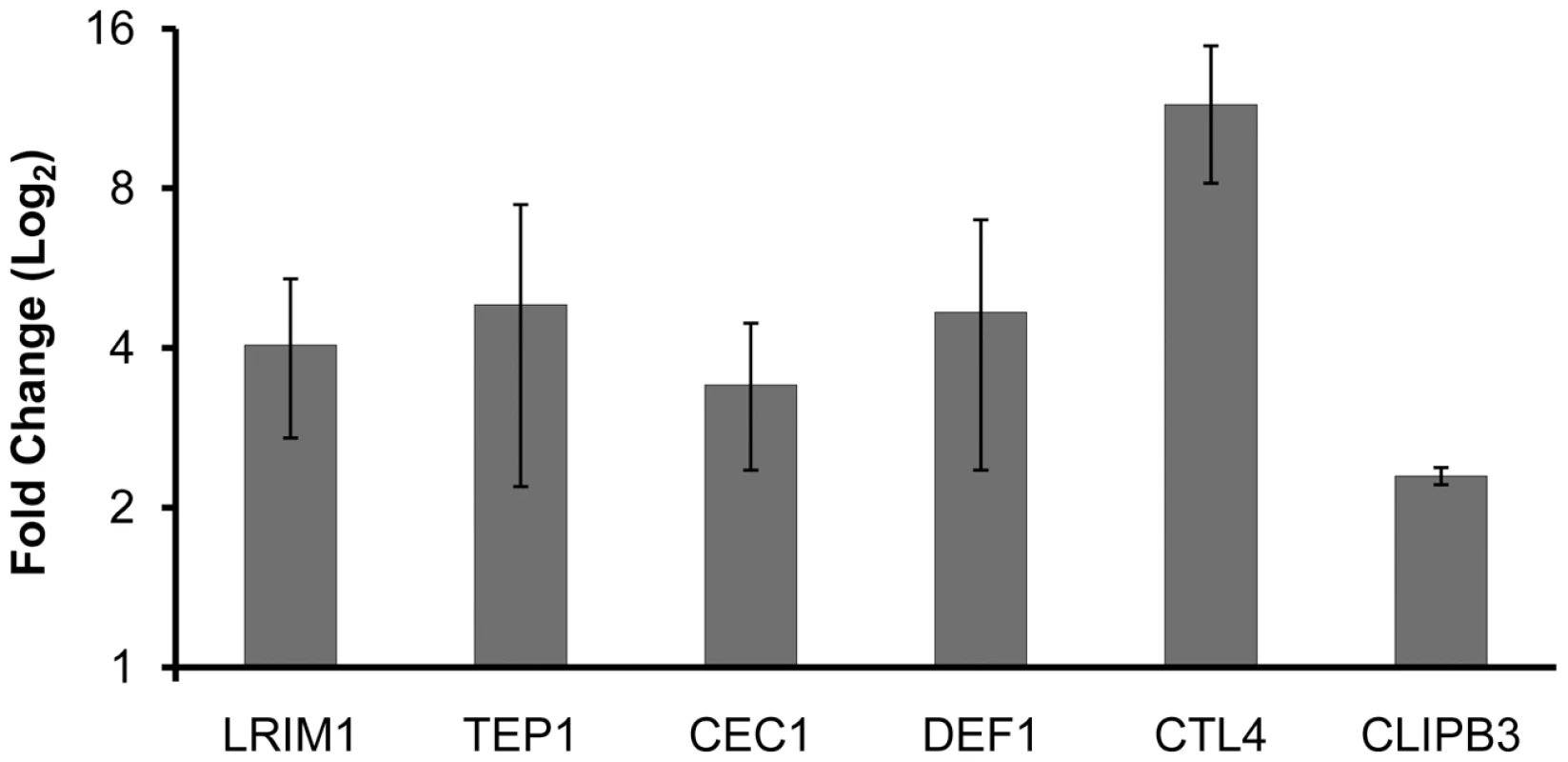
Effects on the development of Plasmodium berghei
Three Plasmodium berghei challenge experiments were conducted on transiently Wolbachia-infected A. gambiae females compared to buffer injected, uninjected, and in one case E. coli-injected controls (Figure 3a–c). In all three experiments highly significant reductions in intensity of oocyst infection in the wMelPop transinfected females were observed compared to the other treatments, while there were no significant differences between any of the control treatments within each experiment. Mean P. berghei intensities were reduced in the wMelPop-infected mosquitoes by between 75% and 84% compared to the corresponding buffer injected control groups. A further experiment confirmed the lack of any significant differences in intensity between the E. coli-injected, buffer injected and uninjected controls (data not shown).
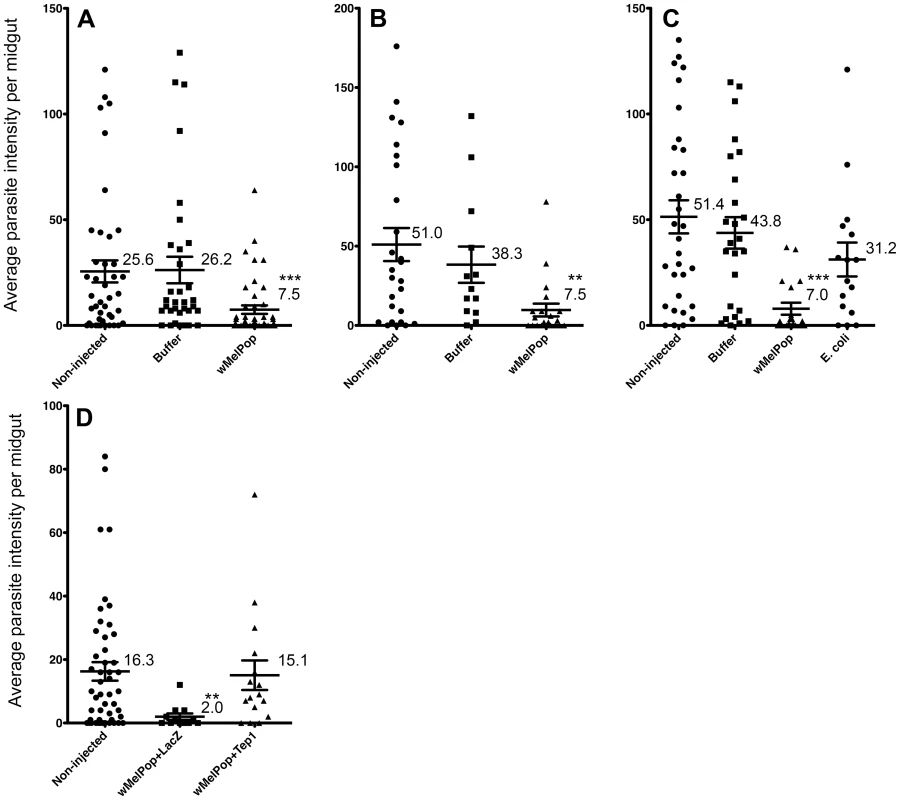
In order to obtain evidence for a causal link between the immune upregulation and the Plasmodium inhibition phenotypes, TEP1 knockdown was undertaken by injection of dsRNA at the same time as Wolbachia injection. Significantly higher oocyst numbers were observed compared to the control where dsLacZ was injected at the same time as Wolbachia (Figure 3d). This experiment provides evidence for a significant contribution of Wolbachia-induced TEP1 upregulation to the Plasmodium inhibition phenotype.
Utility of transient somatic wMelPop infections
We assessed the utility of the transient wMelPop somatic infection model by comparing the effects on host immunity and pathogen development with those observed in stable inherited infections of wMelPop. To do this we utilized a filarial nematode-susceptible line of another mosquito species, Ae. aegypti, in which we have previously carried out Brugia pahangi challenges on a stable wMelPop-transinfected line [7], [12]. We created somatic wMelPop infections using exactly the same methodology as carried out for An. gambiae, and after eight days challenged them with B. pahangi or carried out qRT-PCR.
The somatic Wolbachia infection also induced upregulation of selected immune genes (PGRPS1, CECD, CLIPB37, CTL) (Figure 4a). The scale of upregulation was considerably lower than observed in the comparable Ae. aegypti stable transinfection as previously reported [12]. Likewise, challenge of the somatically wMelPop infected females with B. pahangi did produce a significant reduction in the numbers developing to the L3 (infectious) stage compared to the controls (Figure 4b), as was previously observed in the stable inherited wMelPop infected line, which showed >50% reduction in mean numbers of L3 compared to the Wolbachia-uninfected control at the same microfilarial challenge density [12]. Using quantitative PCR comparing three groups of two mosquitoes with the single copy genes ftsZ (Wolbachia) and Actin5C (Ae. aegypti) for normalization, we estimated that there were approximately 176±70 times more wMelPop cells in the stably infected line compared to the somatic infections. This may explain this reduced effect on gene upregulation. Therefore we conclude that intrathoracic inoculation can be a valuable way to test the effects of Wolbachia on host immunity and pathogen transmission. Although extrapolations to different mosquito species and parasites must be made with care, it does seem likely that the effects observed for somatic Wolbachia infections using the methodology reported here are likely to be smaller than for a stable inherited infection, and thus that the estimations made may be conservative.
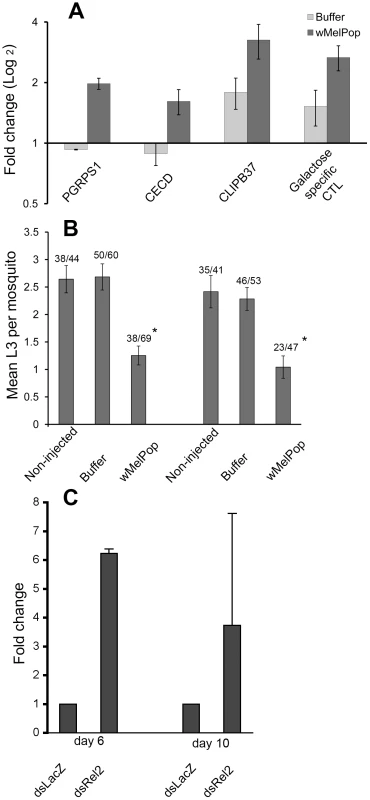
An experiment to test whether the immune upregulation observed in wMelPop-infected mosquitoes affects the density of the Wolbachia itself was conducted using the stable inherited infection of wMelPop in an Ae. aegypti Refm background [7], [12]. Wolbachia ftsZ gene expression (used as a proxy for Wolbachia density) was found to be higher in dsRel2-injected than in dsLacZ-injected mosquitoes at both day six and day ten post-injection (Figure 4c). These data suggest that the immune effectors controlled by the Imd (Rel2-controlled) pathway can influence Wolbachia densities. The very high rate of maternal transmission observed in wMelPop-infected Ae. aegypti [7], despite chronic immune upregulation, means that the biological significance of this density difference is unknown, although potentially it could act to limit wMelPop pathogenicity to some degree. More comprehensive experiments addressing this question will make use of transgenic immune knockdown lines infected with wMelPop, which are currently being produced, and are expected to enable the effects of stronger and more long lasting immune pathway knockdown to be investigated.
Discussion
The data reported strongly support the hypothesis that wMelPop can inhibit the development of Plasmodium in Anopheles malaria vector mosquitoes. The An. gambiae/P. berghei combination, although not one that occurs in nature, does represent a tractable and well studied model for which considerable information is already available about Plasmodium killing mechanisms; however we recognize the challenge experiments will ultimately need to be repeated with the far less tractable human parasite P. falciparum once a stably inherited Wolbachia transinfected line of An. gambiae has been created. The densities of P. berghei used in laboratory challenges such as these can be high compared to those of P. falciparum that would occur in nature, although the mean intensities recorded in these studies lie within the range recorded for P. falciparum in the field. The significant reductions in intensity we recorded in laboratory experiments are considered likely to translate to significant reductions in oocyst prevalence/transmission in a real-life setting.
The knockdown experiment provided evidence for a major role of TEP1, and by extension LRIM1 whose products interact as part of the same opsonization pathway [20], in the inhibition of P. berghei development. This is the first time a direct link between the Wolbachia pathogen inhibition and immune upregulation phenotypes has been made. A more detailed and exhaustive investigation of the relative contributions of different components of the Anopheles immune system to Plasmodium killing can be made once stable inherited Wolbachia infections have been established.
Taken together with the recent report of reduction in P. gallinaceum development in wMelPop-infected Ae. aegypti [21], the data increase the desirability of creating stably inherited wMelPop transinfections in important malaria vectors. The potential combination of lifespan shortening and direct inhibition of Plasmodium development in the mosquito would represent a very attractive control strategy, since both of these phenotypes are critical components of malaria vectorial capacity. A simple model exploring relative contributions of these two parameters to vectorial capacity is shown in Figure 5. Though lifespan reduction and Plasmodium inhibition can each substantially reduce the vectorial capacity of a mosquito population, together they act synergistically to reduce transmission. Depending on the scale of lifespan reduction that would be observed under field conditions, which is as yet unknown, the Plasmodium inhibition effect could dramatically increase the efficacy of the wMelPop infection in reducing malaria transmission.
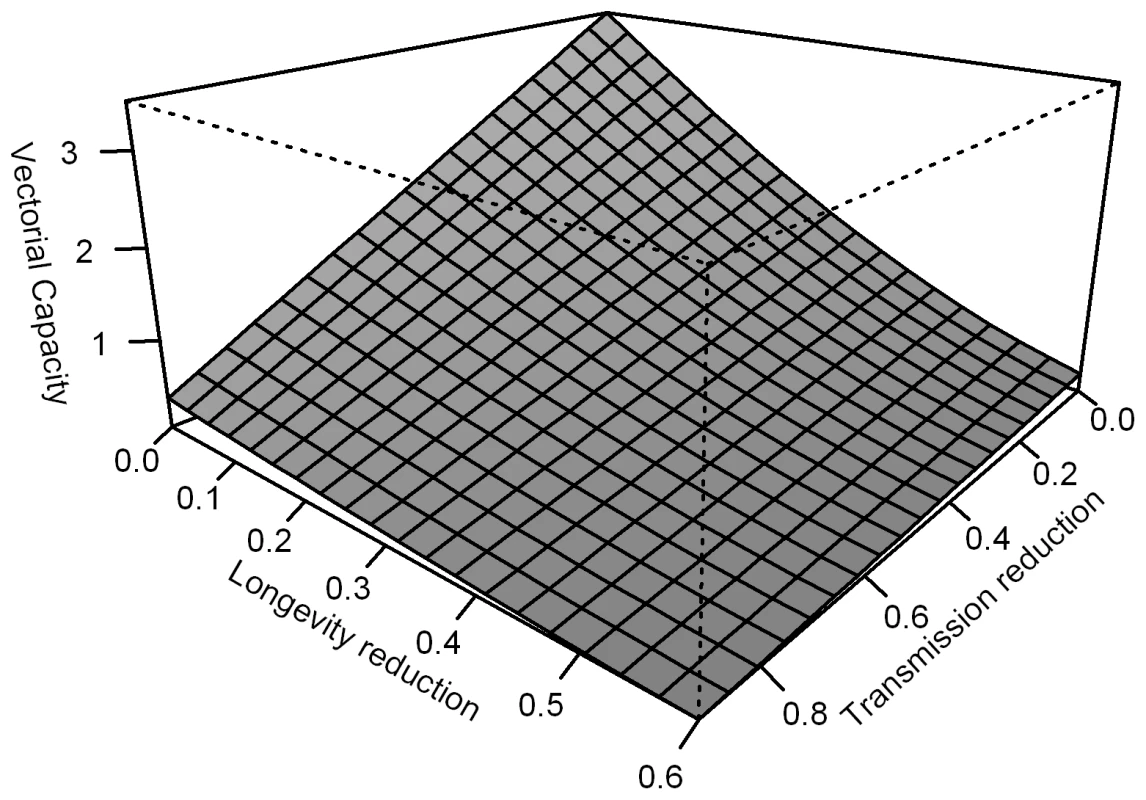
Other Wolbachia strains might also show malaria inhibition effects, particularly if they reach high somatic densities and/or induce large-scale immune stimulation. Here we show that the use of transient somatic infections of Wolbachia by adult female inoculation followed by pathogen challenge is a valuable means to test likely effects on immunity and transmission. This is significant as it allows comparison and selection of strains for the most desirable properties prior to the lengthy, and technically very challenging, process of creating stably inherited Anopheles transinfections. If other Wolbachia strains can be identified which also inhibit Plasmodium transmission, they would represent an attractive alternative to wMelPop if they do not shorten lifespan to the same extent, since they are therefore likely to have much lower fitness costs. Only the wMelPop strain has to date been found to produce a strong life-shortening phenotype.
Laboratory estimates suggest that transinfection of wMelPop in Aedes aegypti can reduce fitness by around 50% [7]. This would appear to make it difficult for this strain of Wolbachia to spread by means of CI through natural populations [26], particularly where populations are fragmented. However, fitness estimates made in relatively benign laboratory conditions, where a comparatively large fraction of the population become old, can overestimate the relative costs of infection. In the field most mosquitoes die early and few live long enough to experience higher Wolbachia-induced mortality (although those that do are significant to disease control, if they would otherwise have lived long enough to transmit the infection). As shown in Figure 5 reductions in longevity and Plasmodium inhibition together determine vectorial capacity and it will also be important to understand the joint effects of the two phenotypes on mosquito fitness in the field. Detailed knowledge of the demographics of the target species is also important [27]. Selective pressures acting on the host would likely modulate the life-shortening phenotype over time, but this may not occur rapidly enough to prevent a sustained period of disease control.
Wolbachia is now known to inhibit the dissemination or development of a variety of insect pathogens and insect-borne pathogens – various Drosophila pathogenic viruses, dengue and chikungunya viruses of humans, and filarial nematode parasites in addition to Plasmodium [12], [21], [28]–[31]. Some of these pathogen-inhibition phenotypes have been reported in Drosophila species that naturally harbour Wolbachia, in other words they are not restricted to species such as Ae. aegypti or An. gambiae in which Wolbachia forms a novel transinfection. On a broader level these Wolbachia cases can be added to various other examples where bacterial symbionts have been shown to provide protective effects against one or more pathogens [32], [33], although the mechanisms involved are likely to be diverse. Parallels can also be drawn with the effects of entomopathogenic fungi, which can both reduce Anopheles lifespan and directly inhibit Plasmodium development [34]–[36]. Pathogen inhibition represents a new and increasingly significant component of our understanding of the effects of Wolbachia in insects, and provides excellent prospects for the development of novel malaria control strategies.
Materials and Methods
Ethics statement
All procedures involving animals were approved by the ethical review committee of Imperial College and by the United Kingdom Government (Home Office), and were performed in accordance with United Kingdom Government (Home Office) and EC regulations.
Somatic wMelPop infections
Wolbachia wMelPop was purified from the infected An. gambiae cell line MOS55 [22], [37] as previously described [23], [24]. This protocol has previously been shown to allow Wolbachia replication in the recipient An. gambiae [24]. Cells obtained from one 75 CM2 flask were re-suspended in 100 µL of Schneider medium without antibiotics (optical density, OD = 0.09). 69 nL of this Wolbachia suspension (or 69 nL Schneider for the controls) were microinjected into the thorax of young An. gambiae females of the G3 strain or Ae. aegypti females of the Refm strain [38] using an Nanoject microinjector (Drummond). The mosquitoes were supplied with 10% sucrose ad libitum and left to recover for at least eight days prior to qRT-PCR or challenge experiments. A similar OD of 0.1 for E. coli was used to inject another set of controls.
qRT-PCR and qPCR
Gene expression levels were monitored using qRT-PCR. Total RNA was extracted with Trizol reagent from groups of ten An. gambiae or Ae. aegypti females maintained at 26°C and 70% relative humidity, and cDNAs were synthesised from 1 µg of total RNA using SuperScript II enzyme (Invitrogen). qRT-PCR was performed on a 1 to 20 dilution of the cDNAs using dsDNA dye SYBR Green I. Reactions were run on a DNA Engine thermocycler (MJ Research) with Chromo4 real-time PCR detection system (Bio-Rad) using the following cycling conditions: 95°C for 15 minutes, then 45 cycles of 95°C for 10s, 59°C for 10s, 72°C for 20s, with fluorescence acquisition at the end of each cycle, then a melting curve analysis after the final one. The cycle threshold (Ct) values were determined and background fluorescence was subtracted. Gene expression levels of target genes were calculated, relative to the internal reference gene Actin5C or RS17 for Ae. aegypti and RS7R for An. gambiae. Primers were designed using Vectorbase (www.vectorbase.org) mosquito gene sequences/orthology criteria, and the wMel genome sequence [39], since wMel and wMelPop are closely related [40]. Primer pairs used to detect target gene transcripts are listed in Table 1.
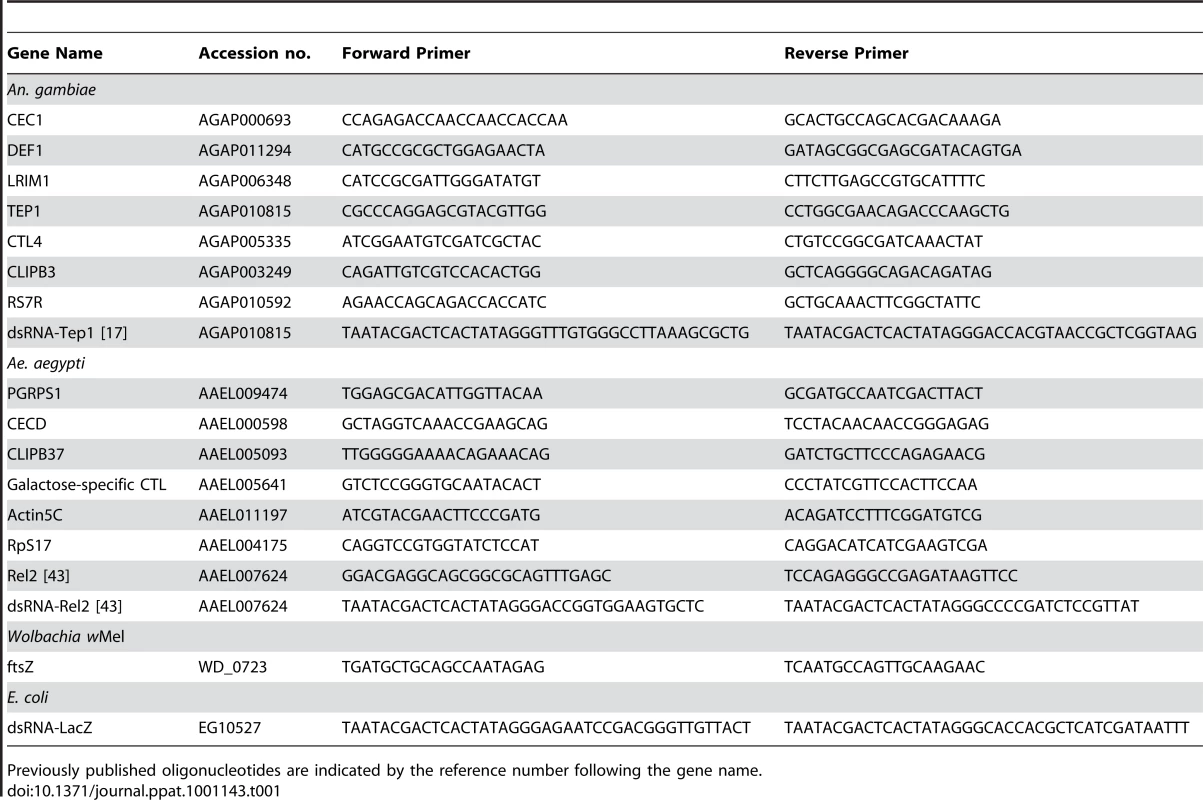
The density of Wolbachia in somatic and stable infections of Ae. aegypti was estimated using both qPCR and qRT-PCR. DNA was extracted using the Livak method and qRT-PCR or qPCR equipment and protocols were the same as those described above. The single copy genes ftsZ (Wolbachia) and Actin5C and S7 (Ae. aegypti) were used to estimate relative numbers of Wolbachia normalized against the mosquito genome.
Plasmodium berghei challenge experiments
General parasite maintenance was carried out as previously described [41]. P. berghei ANKA 2.34 parasites were maintained in 4–10-week-old female Theiler's Original (TO) mice by serial mechanical passage (up to a maximum of eight passages). Hyper-reticulocytosis was induced 2–3 days before infection by treating mice with 200µL i.p. phenylhydrazinium chloride (6mg/ml in PBS; ProLabo UK). Mice were infected by intraperitoneal (i.p.) injection and infections were monitored on Giemsa-stained tail blood smears.
In four independent experiments, individual 4–10 week old Theiler's Original (TO) mice were treated with 200µL i.p. phenylhydraziuium chloride (PH; 6mg/ml in PBS; ProLabo UK) to induce hyper-reticulocytosis. Three days later mice were injected by intraperitoneal (i.p.) injection with 106 parasites of P. berghei ANKA 2.34 as described previously [41]. Three days post mouse infection, batches of 100 starved Anopheles gambiae strain G3 females, eight days post injection with Wolbachia, buffer, E. coli or uninjected controls, were allowed to feed on the infected mice. 24h after feeding, mosquitoes were briefly anesthetized with CO2, and unfeds removed. Mosquitoes were then maintained on fructose [8% (w/v) fructose, 0.05% (w/v) p-aminobenzoic acid] at 19–22°C and 50–80% relative humidity. At day 10 post-feeding, mosquito midguts were dissected, and oocyst numbers (intensity) and prevalence recorded. The Kruskal-Wallis test was used to compare oocyst counts (intensity of infection) and Fisher's exact test for prevalence (percentage of mosquitoes containing at least one oocyst).
Gene knockdown experiments
T7-tailed primers (see Table 1) were used to amplify fragments of the TEP1 and REL2 gene from female cDNA template or the LacZ gene from E. coli total DNA. dsRNA was synthesized using the T7 Megascript kit (Ambion) and adjusted to a concentration of 3 or 4 µg/µl in RNAse free water for dsREL2 and dsTEP1 respectively. For REL2 KD 69nl of dsRNA were injected per female mosquito, For TEP1-wolbachia KD 69 nl of a mix of 2 parts dsRNA to 1 part of purified wMelPop in Schneider's medium (OD 0.3) were injected into the thorax of CO2 anesthetized female An. gambiae mosquitoes (total ∼200 per group). Five days after injection (in order to still fall within the gene knockdown period), mosquitoes were fed on a Plasmodium infected mouse.
Brugia pahangi filarial nematode challenge
Ae. aegypti mosquitoes of the filaria-susceptible Refm strain were fed on sheep blood containing 23 B. pahangi microfilaria per µL eight days post Wolbachia innoculation, plus buffer-injected controls of the same age; any females that did not feed properly were removed. Dissections were carried out 10 days after the infective blood meal under a dissecting stereomicroscope. Kruskal-Wallis tests were used to compare counts of B. pahangi L3 (infective stage larvae).
Zdroje
1. HilgenboeckerK
HammersteinP
SchlattmannP
TelschowA
WerrenJH
2008 How many species are infected with Wolbachia? - a statistical analysis of current data. FEMS Microbiol Lett 281 215 220
2. SinkinsSP
2004 Wolbachia and cytoplasmic incompatibility in mosquitoes. Insect Biochem Mol Biol 34 723 729
3. TurelliM
HoffmannAA
1991 Rapid spread of an inherited incompatibility factor in California Drosophila. Nature 353 440 2
4. TurelliM
HoffmannAA
1995 Cytoplasmic incompatibility in Drosophila simulans: dynamics and parameter estimates from natural populations. Genetics 140 1319 1338
5. HoffmannAA
TurelliM
1997 Cytoplasmic incompatibility in insects.
O'NeillRV
HoffmannAA
WerrenJH
Influential Passengers Oxford Oxford University Press 42 80
6. MinKT
BenzerS
1997 Wolbachia, normally a symbiont of Drosophila, can be virulent, causing degeneration and early death. Proc Natl Acad Sci U S A 94 10792 10796
7. McMenimanCJ
LaneRV
CassBN
FongAW
SidhuM
2009 Stable introduction of a life-shortening Wolbachia infection into the mosquito Aedes aegypti. Science 323 141 144
8. BrownsteinJS
HettE
O'NeillSL
2003 The potential of virulent Wolbachia to modulate disease transmission by insects. J Invertebr Pathol 84 24 29
9. SinkinsSP
O'NeillSL
2000 Wolbachia as a vehicle to modify insect populations.
HanderAM
JamesAA
Insect Transgenesis: Methods And Applications Boca Raton CRC Press 271 287
10. RasgonJL
StyerLM
ScottTW
2003 Wolbachia-induced mortality as a mechanism to modulate pathogen transmission by vector arthropods. J Med Entomol 40 125 132
11. CookPE
McMenimanCJ
O'NeillSL
2008 Modifying insect population age structure to control vector-borne disease. Adv Exp Med Biol 627 126 140
12. KambrisZ
CookPE
PhucHK
SinkinsSP
2009 Immune activation by life-shortening Wolbachia and reduced filarial competence in mosquitoes. Science 326 134 136
13. GwadzRW
KaslowD
LeeJY
MaloyWL
ZasloffM
1989 Effects of magainins and cecropins on the sporogonic development of malaria parasites in mosquitoes. Infect Immun 57 2628 2633
14. KimW
KooH
RichmanAM
SeeleyD
VizioliJ
2004 Ectopic expression of a cecropin transgene in the human malaria vector mosquito Anopheles gambiae (Diptera: Culicidae): effects on susceptibility to Plasmodium. J Med Entomol 41 447 455
15. MeisterS
KanzokSM
ZhengXL
LunaC
LiTR
2005 Immune signaling pathways regulating bacterial and malaria parasite infection of the mosquito Anopheles gambiae. Proc Natl Acad Sci U S A 102 11420 11425
16. FroletC
ThomaM
BlandinS
HoffmannJA
LevashinaEA
2006 Boosting NF-kappaB-dependent basal immunity of Anopheles gambiae aborts development of Plasmodium berghei. Immunity 25 677 685
17. GarverLS
DongY
DimopoulosG
2009 Caspar controls resistance to Plasmodium falciparum in diverse anopheline species. PLoS Pathog 5 e1000335
18. BlandinS
ShiaoSH
MoitaLF
JanseCJ
WatersAP
2004 Complement-like protein TEP1 is a determinant of vectorial capacity in the malaria vector Anopheles gambiae. Cell 116 661 670
19. BlandinSA
Wang-SattlerR
LamacchiaM
GagneurJ
LycettG
2009 Dissecting the genetic basis of resistance to malaria parasites in Anopheles gambiae. Science 326 147 150
20. PovelonesM
WaterhouseRM
KafatosFC
ChristophidesGK
2009 Leucine-rich repeat protein complex activates mosquito complement in defense against Plasmodium parasites. Science 324 258 261
21. MoreiraLA
Iturbe-OrmaetxeI
JefferyJA
LuG
PykeAT
2009 A Wolbachia symbiont in Aedes aegypti limits infection with dengue, Chikungunya, and Plasmodium. Cell 139 1268 1278
22. McMenimanCJ
LaneAM
FongAW
VoroninDA
Iturbe-OrmaetxeI
2008 Host adaptation of a Wolbachia strain after long-term serial passage in mosquito cell lines. Appl Environ Microbiol 74 6963 6969
23. RasgonJL
GamstonCE
RenX
2006 Survival of Wolbachia pipientis in cell-free medium. Appl Environ Microbiol 72 6934 6937
24. JinC
RenX
RasgonJL
2009 The virulent Wolbachia strain wMelPop efficiently establishes somatic infections in the malaria vector Anopheles gambiae. Appl Environ Microbiol 75 3373 3376
25. DobsonSL
BourtzisK
BraigHR
JonesBF
ZhouW
1999 Wolbachia infections are distributed throughout insect somatic and germ line tissues. Insect Biochem Mol Biol 29 153 160
26. TurelliM
2010 Cytoplasmic incompatibility in populations with overlapping generations. Evolution 64 232 241
27. JefferyJAL
YenNT
NamVS
NghiaLT
HoffmannAA
2009 Characterizing the Aedes aegypti population in a Vietnamese village in preparation for a Wolbachia-based mosquito control strategy to eliminate dengue. PloS Negl Trop Dis 3 e552
28. HedgesLM
BrownlieJC
O'NeillSL
JohnsonKN
2008 Wolbachia and virus protection in insects. Science 322 702
29. TeixeiraL
FerreiraA
AshburnerM
2008 The bacterial symbiont Wolbachia induces resistance to RNA viral infections in Drosophila melanogaster. PLoS Biol 6 e1000002
30. OsborneSE
LeongYS
O'NeillSL
JohnsonKN
2009 Variation in antiviral protection mediated by different Wolbachia strains in Drosophila simulans. PLoS Pathog 5 e1000656
31. BrownlieJC
JohnsonKN
2009 Symbiont-mediated protection in insect hosts. Trends Microbiol 17 348 354
32. OliverKM
RussellJA
MoranNA
HunterMS
2003 Facultative bacterial symbionts in aphids confer resistance to parasitic wasps. Proc Natl Acad Sci U S A 100 1803 1807
33. ScarboroughCL
FerrariJ
GodfrayHC
2005 Aphid protected from pathogen by endosymbiont. Science 310 1781
34. BlanfordS
ChanBH
JenkinsN
SimD
TurnerRJ
2005 Fungal pathogen reduces potential for malaria transmission. Science 308 1638 1641
35. ScholteEJ
Ng'habiK
KihondaJ
TakkenW
PaaijmansK
2005 An entomopathogenic fungus for control of adult African malaria mosquitoes. Science 308 1641 1642
36. BellAS
BlanfordS
JenkinsN
ThomasMB
ReadAF
2009 Real-time quantitative PCR for analysis of candidate fungal biopesticides against malaria: technique validation and first applications. J Invert Pathol 100 160 168
37. MarhoulZ
PudneyM
1972 A mosquito cell line (MOS55) from Anopheles gambiae larvae. Trans R Soc Trop Med Hyg 66 183 184
38. MacdonaldWW
SheppardPM
1965 Cross-over values in the sex chromosomes of the mosquito Aedes aegypti and evidence of the presence of inversions. Ann Trop Med Parasitol 59 74 87
39. WuM
SunLV
VamathevanJ
RieglerM
DeBoyR
2004 Phylogenomics of the reproductive parasite Wolbachia pipientis wMel: A streamlined genome overrun by mobile genetic elements. PLoS Biol 2 e327
40. SunLV
RieglerM
S. L. O'NeillSL
2003 Development of a physical and genetic map of the virulent Wolbachia strain wMelPop. J Bacteriol 185 7077 7084
41. SindenRE
2002 Molecular interactions between Plasmodium and its insect vectors. Cell Microbiol 4 713 724
42. SmithDL
McKenzieFE
2004 Statics and dynamics of malaria infection in Anopheles mosquitoes. Malar J 3 n13
43. MagalhaesT
LeandroDC
AyresCF
2010 Knock-down of REL2, but not defensin A, augments Aedes aegypti susceptibility to Bacillus subtilis and Escherichia coli. Acta Trop 113 167 173
Štítky
Hygiena a epidemiologie Infekční lékařství LaboratořČlánek vyšel v časopise
PLOS Pathogens
2010 Číslo 10
- Stillova choroba: vzácné a závažné systémové onemocnění
- Perorální antivirotika jako vysoce efektivní nástroj prevence hospitalizací kvůli COVID-19 − otázky a odpovědi pro praxi
- Diagnostika virových hepatitid v kostce – zorientujte se (nejen) v sérologii
- Parazitičtí červi v terapii Crohnovy choroby a dalších zánětlivých autoimunitních onemocnění
- Jak souvisí postcovidový syndrom s poškozením mozku?
Nejčtenější v tomto čísle
- Retroviral RNA Dimerization and Packaging: The What, How, When, Where, and Why
- Viral Replication Rate Regulates Clinical Outcome and CD8 T Cell Responses during Highly Pathogenic H5N1 Influenza Virus Infection in Mice
- Antimicrobial Peptides: Primeval Molecules or Future Drugs?
- Crystal Structure of DotD: Insights into the Relationship between Type IVB and Type II/III Secretion Systems
